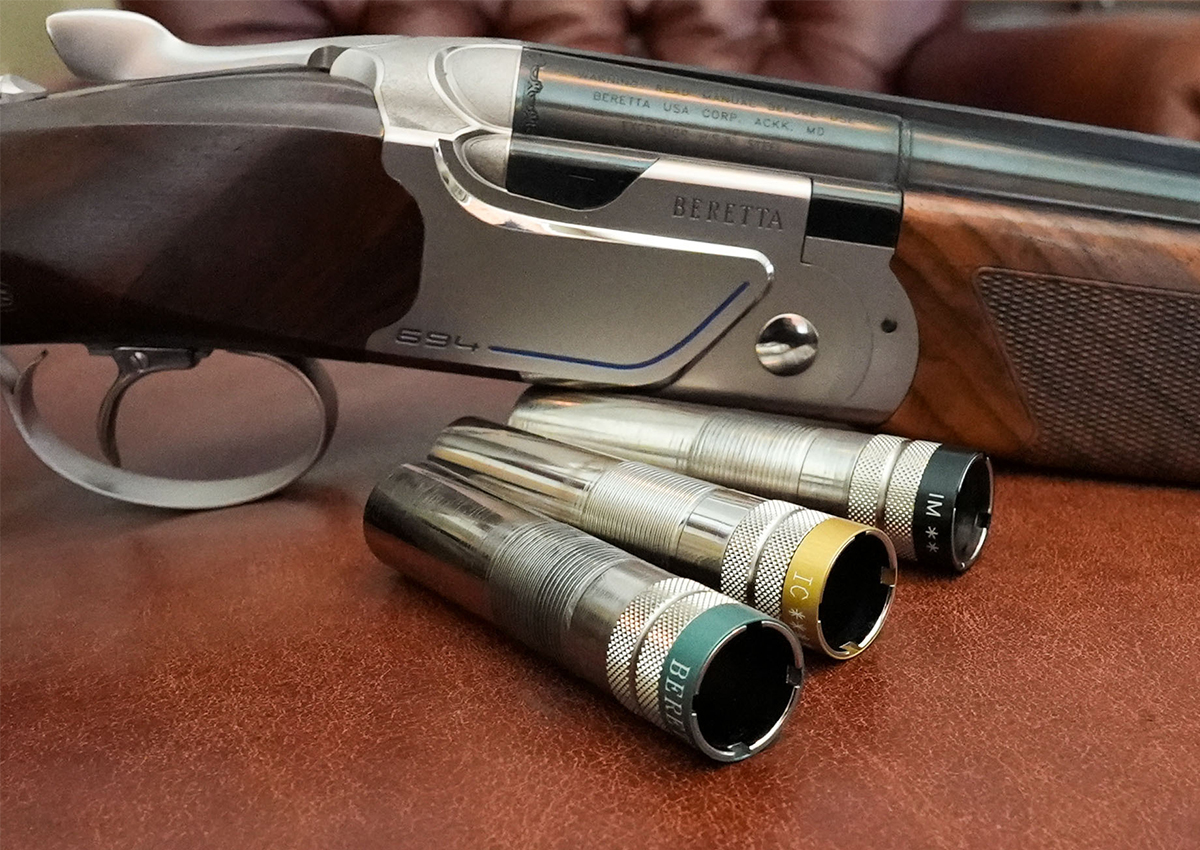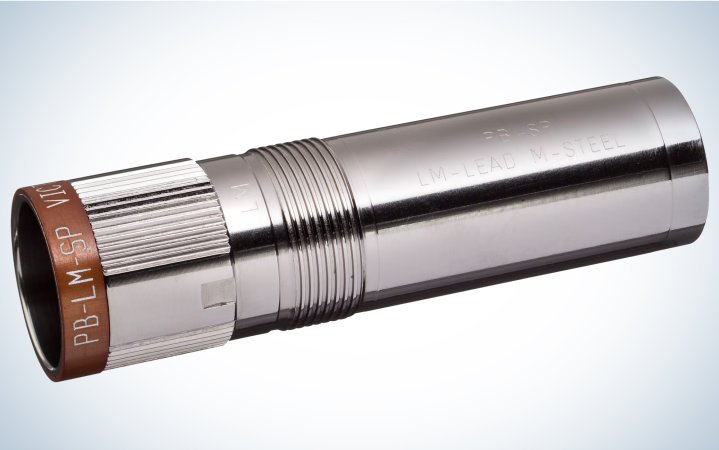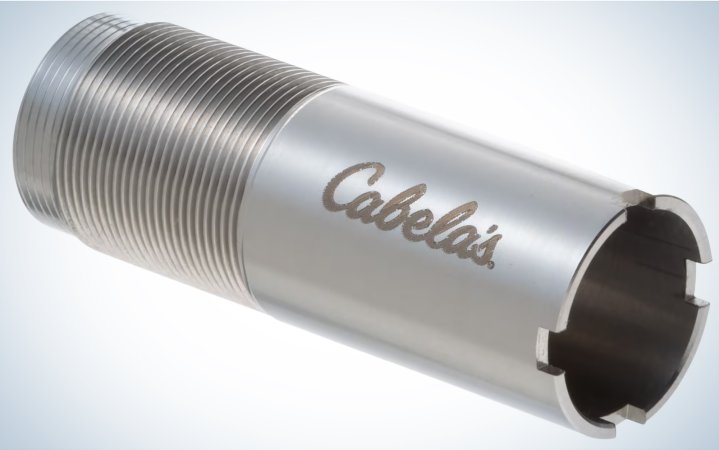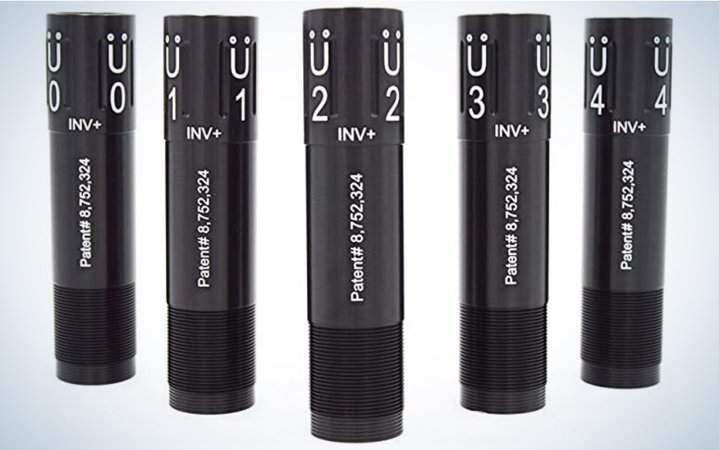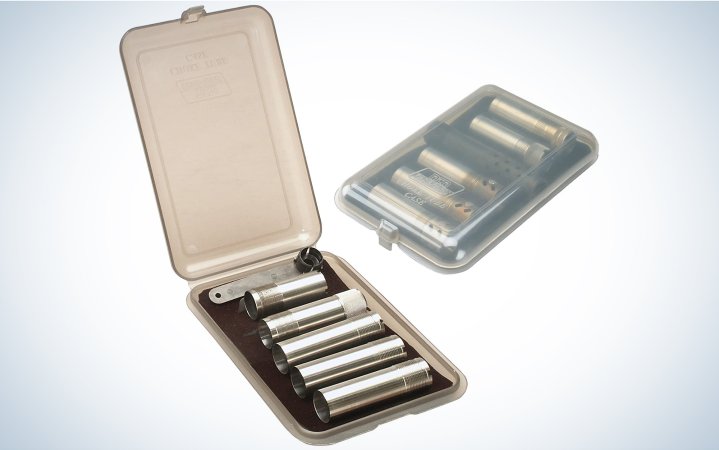We may earn revenue from the products available on this page and participate in affiliate programs. Learn More ›
Asking what the best sporting clays choke is a lot like asking a group of hunters what’s the best breed of bird dog. You’re going to get a lot of heated opinions, which may or may not be based in fact. And like our question about the bird dogs, the answer is often, it depends, and a fancy pedigree or high price tag might not translate to better performance.
Not all after-market sporting clays chokes are created equal, however. They use different materials and have different features, which are worth taking into consideration before making a purchase. Here are the best chokes for sporting clays and, more importantly, how to choose the best choke for you.
- Beretta Victory Mobilchoke Extended Chokes
- Beretta Optima-Choke HP
- Briley Complete Sporting Clays Choke Package
- Browning Midas Chokes
- Cabelas Choke Tubes
- Carlson’s Chokes
- Trulock Choke Tubes
How Shotgun Chokes Work
Chokes in shotguns work by constricting the diameter of the bore near the muzzle. Tighter constriction—meaning the narrower the opening—will result in tighter shotgun patterns downrange. The goal is to match the degree of constriction with the distance to the target and the type of target you’re shooting.
The farther away the target, the more constriction you want. The narrower the profile of the target—for example a clay where you can only see the edge—the more constriction you want as well.
There’s no single standard definition of the amount of choke constriction for the different chokes, but most step down in .005-inch increments.
Sporting Clays Choke Constriction
The standard 12 gauge has a bore diameter of .729 inches. But many shotguns deviate from this and run larger bore diameters. If you see a shotgun marketed as “over-bored” you know the bore is larger than .729 inches. Browning shotguns, for instance, are bored .742 inches.
A cylinder choke has no constriction, so it maintains the shotgun’s bore diameter. Most chokes decrease the bore diameter in .005-inch increments. So a skeet choke is .005 inches under the nominal bore diameter, improved cylinder is .010 inches smaller, and so on. Here are the typical amounts of constriction you’ll find with various after-market chokes though, as always, there are exceptions.
| Choke | Constriction |
|---|---|
| Cylinder (C or Cyl) | .000 in. |
| Skeet (SK) | .005 in. |
| Improved Cylinder (IC) | .010 in. |
| Light Modified (LM) | .015 in. |
| Modified (M or Mod) | .020 in. |
| Improved Modified (IM) | .025 in. |
| Light Full (LF) | .030 in. |
| Full (F) | .035 in. |
| Extra Full (EF) | .040 in. |
How to Pick the Best Sporting Clays Choke for Your Shotgun
The most important thing with any choke you get is to test it with the load you plan to use. Chokes will pattern differently from one gun to the next and will pattern different shotgun loads differently as well. So what might be the best sporting clays choke for your gun might not deliver good patterns in your buddy’s — even if he shoots the same type of shotgun you do.
There’s more information about how to pattern a gun at the end of this article, but the key is that you need to test any choke with your specific setup to determine whether it works for you.
The Three Best Sporting Clays Chokes to Buy
If you’re assembling a basic assortment of sporting clays chokes it’s best to get three—one each for close-, mid- and long-range targets. The close-range targets can be taken with cylinder, skeet or improved cylinder chokes; the mid-range targets with light mod or mod chokes; and the long-range targets with improved mod, full, or extra full.
The majority of any round of sporting clays will consist of close and mid-range targets, so a skeet and modified combo is a smart choice. Round that out with a full choke for the longer shots and you’re good to go.
But as always, you’ll need to test each of the chokes to make sure it is patterning correctly, impacting in line with your point of aim and delivering consistent patterns that don’t have holes that a target can sneak through.
Sporting Clays Choke Features
Many chokes for sporting clays extend beyond the muzzle and have some type of texture machined into them. This is so they can be switched out easily by hand and checked for tightness without the need for a special choke wrench.
They almost always have some kind of indication of their constriction that’s visible when the choke is inserted in the barrel. Some incorporate colors on the extended portion as well for easy visual identification.
The most frequently used material for sporting clays chokes is stainless steel, usually 17-4 PH, which provides good corrosion resistance. Some are made of chromoly steel, the same material that shotgun barrels are made of. Having the choke and barrel made from the same type of steel can help the shotgun pattern better, though chromoly chokes can be more prone to corrosion unless they have some other protective coating applied. Some chokes are made of titanium and aluminum as well.
Best Chokes for Sporting Clays: Reviews & Recommendations
Beretta Victory Mobilchoke Extended Chokes
Beretta Victory Mobilchoke
Beretta shotguns use one of four different choke styles, depending on the specific model. Those are the Mobilchoke, Optima, Optima HP and Optima Plus. Though the Optima and Optima HP chokes look similar, they are not interchangeable, so make sure you order the right one for your shotgun.
The Mobilchoke is the oldest of the four designs and dates to the mid-1980s. Today it is still used on some 680-series shotguns, the A300 Outlander, and some 391 models. It is common on many older Beretta models. It is the only choke system Beretta offers in all four gauges: 12, 20, 28 and .410.
The Victory Mobil chokes extend about an inch beyond the muzzle and are color coded for quick visual identification. You can get them in skeet, IC, modified and full in 12 and 20 gauge.
Beretta Optima-Choke HP
Beretta Optima-Choke HP
This choke system is the most common on current Beretta competition shotguns. It is also the newest of Beretta’s choke designs. It was unveiled in 2008 with the introduction of the SV-10 Perenina and Previal series.
It was designed to handle heavy volumes of shooting with steel shot while keeping weight to a minimum.

In addition to the SV-10, the Optima-Choke HP is featured on the DT-11, 692, 690, UGB 25, A400 Xtreme, A400 Xplor, A400 Xcel, and A300 Xtrema.
They are made from stainless steel and are nickel coated for protection against corrosion. The chokes are very nicely finished with dual bands of machined checkering in the extended portion for a positive grip and elegant look.
Briley Complete Sporting Clays Choke Package
Briley Complete Sporting Clays Choke Package
Briley is one of the top names in after-market chokes for sporting clays and is one of the most popular upgrades you’ll see on competition shotguns. They make competition chokes for all major manufacturers.
One of their most popular offerings is the Complete Sporting Clays Choke Package, which is a set of five chokes constricted skeet, IC, LM, Mod., and IM. While not cheap the package does include Briley’s high-quality Speed Wrench.
The chokes are knurled at the end for easy installation and removal and are color coded. Briley polishes the interior of their tubes to minimize pellet deformation.
Browning Midas Chokes
Browning Midas Chokes
These chokes work with shotguns that are threaded for Browning’s Invector-Plus choke system, which Browning introduced back in the 1990s. The others are the Invector DS, which was introduced around 2008, and the original standard Invector. They are not interchangeable so make sure you know what type of choke your shotgun uses before buying.
The Midas chokes have diamond-pattern knurling on the extended portion of the choke that give a good grip. They are easy to change by hand in the field without the need for a wrench.
The chokes also have a metallic band in Browning’s signature gold with the choke’s constriction printed on it.
They are made of stainless steel and are coated with a black oxide finish for durability. Browning polishes the inside to a high degree of smoothness in order to minimize the buildup of residue from plastic wads.
The diameters they offer are as follows: Skeet .737 in. / IC .732 in. / Mod. .722 in. / IM .717 in. / Full .707 in.
Cabelas Choke Tubes
For shooters on a budget, Cabela’s flush-mounted choke tubes are a good option. While they don’t have some features found on higher-end chokes, like extended gripping surfaces and external markings showing constriction, they do choke down patterns, which is what really counts.
They are made of stainless steel and are notched for installation and removal with standard choke wrenches.
You can get them in 12 and 20 gauge in the following constrictions: skeet, IC, modified, full and extra full.
Cabelas has models that fit Remington, Benelli, Browning Invector Plus, Mossberg 835 and Winchester shotguns.
Carlson’s Chokes
Carlson’s makes a staggering array of chokes for different uses including sporting clays. They have many models to choose from, including some very pimped-out metallic gold ported chokes that make quite the statement.
Shown here is one of their newer sporting clays models with a black finish that’s a bit more understated. They are made from 17-4 stainless and have a knurled gripping surface on the end.
The chokes are etched with their constriction on the extended part of the tube for quick identification and have more detail printed on the body of the choke, including the choked down bore diameter and the type of shot the choke is rated for.
These choke tubes can be shot with pretty much any shot material. The exception is steel shot that’s larger than BB or that has a muzzle velocity in excess of 1550 fps is not suitable for Carlson’s full and extra full chokes. Other than that, you’re good to go.
The chokes are made in the U.S. and have a lifetime warranty.
Muller Chokes
Muller Chokes
Muller is a relatively newcomer to the aftermarket choke scene—founder Jimmy Muller didn’t start seriously marketing his chokes until 2008—but these distinctive tubes have found a devoted following among hunters and competitive shooters.
Muller’s biggest claim to fame is his Featherlight Competition series, which are made of aluminum and ceramic, making them one of the lighter chokes on the market. Those chokes are more fragile than stainless steel chokes and are restricted in terms of what can be shot through them. They are limited to lead shot payloads of 1 1/8 ounces or less with shot no larger than No. 7.5.
Muller also makes stainless steel chokes for hunting and competition that are rated for all types of shot. They are Cerakoted to protect against the elements.
Visually, Muller chokes are easy to identify with their fluting and unique marking system. The constriction on the extended chokes is indicated by an umlauted “U” followed by a number (0 to 4) going from skeet to extra full as follows: Ü0 cylinder/skeet, Ü1 skeet/IC, Ü2 light mod/mod, Ü3 mod/improved mod, Ü4 full/extra full.
Muller doesn’t have a set degree of constriction for its chokes as the specific amount is tuned for each platform, but on average they are: Ü0 .002 in. / Ü1 .005 in. / Ü2 .012 in. / Ü3 .022 in. / Ü4 .035 in.
Muller chokes are available for all major shotgun platforms and come with a 60-day money back guarantee.
Trulock Choke Tubes
Trulock
Trulock has been a mainstay of the aftermarket choke industry since 1981 when founder George Trulock started manufacturing. His chokes enjoy a sterling reputation with shotgunners and are used as OEM items by many shotgun companies.
Trulock sporting clays chokes have a knurled head for toolless installation and removal and have a bright finish. They are made of 17-4 stainless steel that’s been heat treated and can be had in either ported or non-ported configurations for all major—and even most minor—shotgun makes.
They are offered in the full array of constrictions starting with cylinder (.000 in.) and then in .005 in. increments as follows: skeet 1 (.005 in.), IC (.010 in.), skeet 2/light mod. (.015 in.), modified (.020 in.), IM (.025 in.), full (.030 in.). Their extra full choke (.040 in.), steps down by .010 in.
All Trulock chokes are marked with the name of the constriction and the exit diameter in thousandths of an inch. They are built in the U.S. and carry a 60-day money back guarantee and a lifetime replacement warrantee.
Sporting Clay Choke Tube Accessories
Birchwood Casey Choke Tube Lube
Adding some lube to your choke tube threads is an essential piece of maintenance. Failure to do so can lead to seized chokes that get frozen in place and can become a real hassle to fix.
This lube from Birchwood Casey is thin and easy to apply and is a good bit of preventative insurance to keep you from making a costly mistake with your shotgun.
MTM Choke Range Case
This simple case holds six extended choke tubes and is a good way to protect your chokes from getting banged around, being exposed to the elements, and from collecting dirt and grit in the threads that can cause unwanted wear with the choke and barrel.
FAQs
Newcomers to the sport of sporting clays are better off concentrating on technique rather than being obsessed with swapping choke tubes between stations. This is because the majority of misses will be due to poor form and loss of focus, rather than pattern density.
Beginners should make hitting easy to moderately difficult targets within 30 yards their priority. So going with either skeet or IC chokes is the best move. As shooters become more proficient and want to get better results and feedback on longer targets, adding a light modified or modified choke to mix can be smart.
Go with chokes tighter than these only when shooting targets at extreme ranges.
You need a target large enough to draw a 30-inch circle on it. Place a dot in the center of the circle for your point of aim.
You’ll want to shoot the target at 25 yards when patterning skeet and cylinder chokes (and all .410 gauge chokes), and at 40 yards for all other chokes. This is the industry standard.
Some people advocate shooting from a bench to minimize input from the shooter. If you do this, take pains to make sure your head is aligned with the stock the same way it is when shooting offhand, or it will change your point of impact.
I prefer to shoot from a standing position by mounting the gun with the barrels pointed slightly upward and then slowly dropping the muzzle until it is aligned with the aiming point and firing.
For best results you’re going to want to do this five times (at least) with each choke and load combination.
It’s a time-consuming process, but there are no shortcuts here.
Your targets will reveal pattern density—measured as the percentage of pellets in the shell that impact within the circle; point of impact; and pattern distribution, which hopefully doesn’t indicate any major gaps where a target can escape unscathed.
If you have a double-barreled shotgun, you’re going to want to pattern with each barrel. In addition to the data gathered above, you’ll figure out if your barrels converge on the same spot.
If you encounter any problems, the best course of action is to start by changing chokes and loads. If that doesn’t fix issues with where your shotgun is impacting or the quality of the patterns then you need to have the gun looked at to figure out what’s going on.
The short answer is no, they don’t make any meaningful difference for sporting clays shooters. The claims that they either reduce felt recoil or minimize muzzle lift aren’t accurate.
Unlike centerfire rifles that produce a lot of pressure and in a bore with a small diameter, shotgun barrels have significantly more volume and shotshells produce much less pressure so any recoil reduction through porting is going to be minimal.
Where ported chokes can make a difference is by gripping and slowing down the shotgun wad, leading to a cleaner separation with the shot column. This can produce tighter and more consistent patterns downrange, but the effect seems limited to shot size No. 4 and larger.
This is why some waterfowlers swear by ported chokes and why they don’t make a difference for sporting clays and other types of smoothbore competition.
Methodology
To make my picks I interviewed over a dozen top sporting clays competitors on the chokes they used and why. The answers on brand and model ran the gamut. But one thing rang true among all the shooters was the need to find a choke that patterned best for their gun and load.
Read Next: Best Gun Cases
Final Thoughts
The bottom line to buying the best choke for sporting clays is that there isn’t a single best option. You have to experiment to find a choke that will pattern best for your gun and load. There’s no getting around that process if you want to win at sporting clays.
